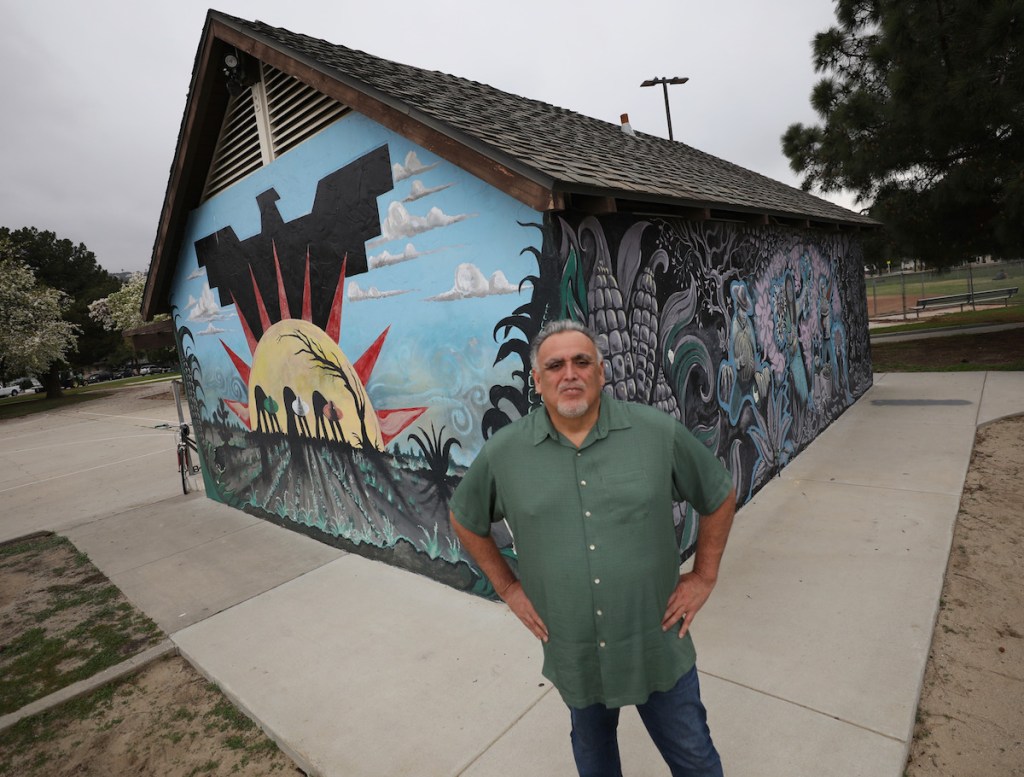Debate over the fate of the iconic Chicano art murals that define Ortega Park on Santa Barbara’s Eastside has heated up so fast in the last two weeks that City Administrator Paul Casey felt compelled to pull an item — having to do with a grant application for a multimillion-dollar makeover proposed for the park — from this week’s City Council agenda. Initially, that vote had been slated for the council’s “consent agenda,” the bailiwick for items deemed such slam dunks that no discussion is necessary. But the debate over the future of Ortega Park and the murals’ rich cultural past demonstrates there’s no such thing as a slam dunk anymore. And a whole lot more discussion will definitely be necessary.
The big question confronting City Hall is to what extent such additional outreach will interfere with the application deadline of March 12 for the $8.5 million grant application City Parks and Recreation Director Jill Zachary hopes to submit to fund the development of an ambitious new plan for Ortega Park, approved by the council last year.
Get the top stories in your inbox by signing up for our daily newsletter, Indy Today.
Most likely, it seems, the March 12 deadline will be blown. As Casey stated, City Hall is “most likely not pursuing the grant at this time.” Instead, he said it made sense to “take a step back, engage with the community again with a focus on the murals. Take our time.”
The challenge with that approach, however, is that there is no plan B. “There is no other grant cycle,” cautioned Zachary. “This is our one shot at applying for Prop. 68 State Park funds.”
Casey’s decision to withdraw the grant application came on the heels of last week’s Historic Landmarks Commission (HLC) meeting, during which the commissioners agreed many of the murals qualified as historically significant and that not nearly enough public outreach had taken place to discuss their fate. On Saturday, supporters of the murals hosted a community forum at which councilmember Alejandra Gutierrez, who represents the Eastside, also expressed strong support for more community outreach.
The grant application — if successful — would have covered much of the $14 million it’s estimated it will cost to build the new-and-improved park. As envisioned, the master plan calls for the installation of a new heated swimming pool, synthetic turf playing fields, a skate park, and basketball and bocce ball courts. This new plan was developed in response to chronic complaints from the community about drinking, drug abuse, prostitution, gambling, and gang activity reportedly taking place at the park. This behavior gave rise to frequent calls for police service and discouraged many community residents from using their neighborhood park.
What was not clear when the council unanimously approved the new plan, however, was what would happen to the park’s 18 murals, many of which date back to the Chicano Pride movement that flourished in Santa Barbara throughout the 1970s. When it became evident at a meeting last November that there was no plan to save the murals — which adorn the walls of park structures deemed too dilapidated or too small to fit into the new design — Eastside neighborhood advocates, including Mark Alvarado, raised the alarm.
In response to that alarm, City Hall hired special consultants who concluded that seven of the 18 murals were of such significance that they merited some form of preservation. Two of the murals, the report concluded, could be relocated in their present form — though at significant cost — and five others could be replicated and then demolished. That report found the Ortega Park murals represented one of only a handful of mural clusters throughout all of Southern California. It was the only one, it found, where which Chumash and Chicano visual and mythological themes were so woven together.
The report also noted that none of the murals were 50 years old, typically the threshold for historical significance. Many were relatively recent. And several had been altered over time. While notable muralists, such as Manuel Unzueta, designed many of the murals over a 40-year span, the report also found most of the actual paint had been applied to concrete by young Eastside residents enlisted into the effort in the spirit of community building. That involvement, the report speculated, could account for why so few of the murals have been vandalized over the years.
That report found itself in front of the HLC last week for approval. Mural supporters such as Alvarado urged the commission to take no action, arguing not enough community outreach had taken place for the commissioners to sign off on it. Approval by the HLC is needed for purposes of environmental review — to certify that any adverse historical impacts of the park’s new master plan would be mitigated.
Parks and Rec staff had countered there had been six workshops and seven public hearings on the new park design in which 450 stakeholders weighed in. Only one person, they said, mentioned the murals. That person, it turns out, was Alvarado, a onetime Parks and Rec employee of some community prominence. But joining Alvarado in front of the HLC last week was Anne Petersen, executive director for the Santa Barbara Trust of Historic Preservation.
Although the commissioners tied themselves in knots over how the murals should be preserved — with two questioning if — they all agreed they were culturally important to the city’s historical fabric. Whether they were as important as the promised new park amenities or less so, the commissioners disagreed. But, they agreed, that wasn’t their decision to make. That decision, they concluded, should be rendered by people who lived in the community and used the park.
This article was underwritten in part by the Mickey Flacks Journalism Fund for Social Justice, a proud, innovative supporter of local news. To make a contribution go to sbcan.org/journalism_fund.

